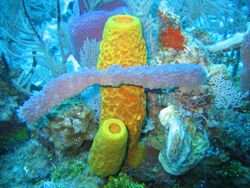Biology:Niphates digitalis
| Pink vase sponge | |
|---|---|

| |
| The pink vase sponge (Niphates digitalis) is seen in the back of the photo, behind three other species of sponges. | |
| Scientific classification | |
| Domain: | Eukaryota |
| Kingdom: | Animalia |
| Phylum: | Porifera |
| Class: | Demospongiae |
| Order: | Haplosclerida |
| Family: | Niphatidae |
| Genus: | Niphates |
| Species: | N. digitalis
|
| Binomial name | |
| Niphates digitalis (Lamarck, 1814)
| |
| Synonyms | |
|
List
| |
Niphates digitalis, commonly known as the pink vase sponge, is a species of sea sponge belonging to the family Niphatidae. It is native to the Florida Keys, The Bahamas, and the Caribbean including the Netherlands Antilles.[1] The species was first described by Jean-Baptiste Lamarck in 1814.[2]
Characteristics
The pink vase sponge is a demosponge that can grow up to 50 cm in height and width, but is more commonly smaller. It is normally vase-, tube-, or cup-shaped with a narrow base and broader top, and somewhat flattened when viewed in cross section. Rarely, it can grow as a fan shape.[3] Despite its name, the colour has been observed as blue, gray, and lavender, as well as "purplish to pink".[1] The surface is coarse and porous with 6-mm-long conules or spines.[3]
Chemistry
Compounds extracted from the pink vase sponge have been investigated for their possible use in the treatment of castration recurrent prostate cancer.[4] A common reagent used in organic chemistry 1,8-diazabicycloundec-7-ene can be isolated from this sponge.[5]
References
- ↑ 1.0 1.1 "Niphates digitalis". Encyclopedia of Life. http://eol.org/pages/338077/details.
- ↑ "Niphates digitalis (Lamarck, 1814)". World Porifera Database. http://www.marinespecies.org/porifera/porifera.php?p=taxdetails&id=166775.
- ↑ 3.0 3.1 "Niphates digitalis (Lamarck, 1814) Haplosclerida, Niphatidae". Portol.org. http://www.portol.org/guide/sp_92.html.
- ↑ "Niphatenones, glycerol ethers from the sponge Niphates digitalis block androgen receptor transcriptional activity in prostate cancer cells: structure elucidation, synthesis, and biological activity.". J Med Chem 55 (1): 503–14. 2012. doi:10.1021/jm2014056. PMID 22148427.
- ↑ Smitha, Graham; Lynchb, Daneil E. (2016). "Crystal structures of three anhydrous salts of the Lewis base 1,8-di-aza-bicyclo-[5.4.0undec-7-ene (DBU) with the ring-substituted benzoic acid analogues 4-amino-benzoic acid, 3,5-di-nitro-benzoic acid and 3,5-di-nitro-salicylic acid"]. Acta Crystallogr E 72 (3): 382–386. doi:10.1107/S205698901600267X. PMID 27006813.
Wikidata ☰ Q569002 entry
 |

